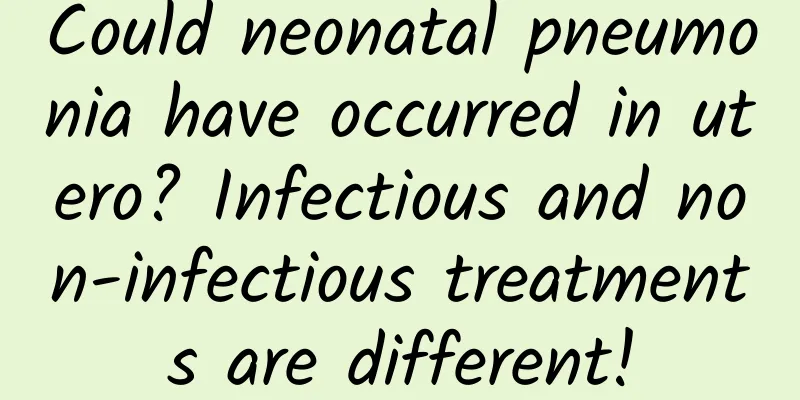Could neonatal pneumonia have occurred in utero? Infectious and non-infectious treatments are different!

|
Author: Wang Yajuan, Chief Physician, Children's Hospital, Capital Institute of Pediatrics Reviewer: Zhang Yu, researcher at Chinese Center for Disease Control and Prevention A newborn refers to a baby within 28 days after leaving the mother's body, from the time the umbilical cord is tied. A child may face various diseases after birth, and pneumonia is a relatively common disease. For neonatal pneumonia, it is divided into infectious pneumonia and non-infectious pneumonia. Figure 1 Original copyright image, no permission to reprint 1. What are the causes of neonatal pneumonia? Non-infectious pneumonia can occur in utero, during delivery, and after birth. For example, the fetus may inhale amniotic fluid or meconium-stained amniotic fluid in utero or during birth, resulting in amniotic fluid aspiration pneumonia or meconium aspiration syndrome. Under normal circumstances, the amniotic fluid is clear and does not contain meconium. However, in special circumstances, such as when the fetus suffers from hypoxia in the uterus and the anal sphincter relaxes, meconium will be discharged and contaminate the amniotic fluid. The fetus does not breathe in the uterus normally, and begins to breathe autonomously after birth. If there is obvious hypoxia in the uterus that causes fetal distress and gasping, it will cause amniotic fluid or meconium to be inhaled into the lungs. Hypoxia during delivery can also cause meconium or amniotic fluid to be inhaled into the lungs. Both amniotic fluid and meconium are foreign bodies to the lungs, and even if they are sterile, they can cause chemical irritation to the lungs, causing pneumonia. If a child is born with special diseases, such as respiratory and digestive tract malformations, he or she may choke and cough when drinking milk, which may lead to milk aspiration pneumonia. Figure 2 Original copyright image, no permission to reprint Infectious pneumonia can also occur in utero, during delivery, and after birth. Intrauterine infectious pneumonia is transmitted to the fetus through amniotic fluid or blood, and intrauterine operations often lead to fetal infection; intrapartum infectious pneumonia is pneumonia caused by inhalation of secretions contaminated by pathogens in the pregnant mother's vagina during delivery; there are two types of postnatal infectious pneumonia, one is community infection, such as family members are infected and transmitted to the child; the other is nosocomial infectious pneumonia, which is an infection that occurs during the child's hospitalization after birth. Figure 3 Original copyright image, no permission to reprint 2. What are the symptoms of neonatal pneumonia? Neonatal non-infectious pneumonia is pneumonia caused by inhalation of amniotic fluid, meconium, and breast milk. Inhalation of amniotic fluid and meconium occurs relatively early, and there may be symptoms of hypoxia in the womb, such as rapid fetal heart rate and frequent fetal movements, which can be detected through ECG monitoring. After the baby is born, mild symptoms may be rapid breathing, and severe symptoms may be dyspnea, manifested as cyanosis, groaning, nasal flaring, and inspiratory three-point sign. In neonatal infectious pneumonia, those caused by intrauterine infection may show symptoms in utero and the child will become ill after birth. The symptoms are very obvious, not just respiratory system symptoms, but also systemic system symptoms. In addition to respiratory difficulties such as rapid breathing, groaning, and inspiratory three-point sign, there may also be poor mental response and poor complexion. In severe cases, there will be symptoms of infectious toxic shock, cold and purple extremities, etc. Theoretically, infectious pneumonia caused during delivery will occur slightly later than intrauterine infectious pneumonia, and may occur one or two days after birth, and most often within three days. It may also manifest as rapid breathing, dyspnea, inspiratory concave sign, and severe cases may have cyanosis. Postnatal infectious pneumonia usually develops relatively late, most of the time appearing three days after birth, and is manifested by poor feeding, easy choking, spitting, heavy breathing, rapid breathing, and severe cases will show signs of infection and poisoning, unstable body temperature, bluish-gray complexion, refusal to feed, and poor reaction. For infectious pneumonia, whether it is caused by intrauterine infection, delivery infection, or postpartum infection, severe cases may cause complications, such as respiratory failure and heart failure. Because the lungs themselves are inflamed, empyema and pyopneumothorax may occur. Severe extrapulmonary complications may cause necrotizing enterocolitis and septic shock. With the improvement of medical standards, timely detection, early diagnosis, and early treatment, these complications are becoming less and less common. Neonatal pneumonia can be diagnosed based on clinical symptoms and signs, as well as auxiliary examinations such as chest X-ray. 3. How to treat neonatal pneumonia? For aspiration pneumonia, the amount of amniotic fluid inhaled is very small, and the child may not show obvious symptoms, or may only have rapid breathing without other symptoms. The condition can be closely observed, and the amniotic fluid will be slowly absorbed in the lungs. If meconium is inhaled, the amount inhaled is relatively small, and the clinical manifestations are not obvious, you can also first observe closely clinically and monitor vital signs, and it may be slowly absorbed. Whether it is amniotic fluid or meconium inhaled, if there is no contamination and it is a sterile inflammation, no antibiotics are needed. If a child inhales amniotic fluid or meconium during birth, the doctor can determine the severity. If the amount inhaled is large, the respiratory and circulatory systems will be affected, which will be life-threatening. The amniotic fluid or meconium should be immediately suctioned and respiratory support should be given if necessary, including oxygen inhalation, non-invasive ventilator support, and invasive ventilator support may be required for severe cases. If the amniotic fluid is contaminated or does not improve for a long time, bacterial infection cannot be ruled out, and antibacterial drugs should be used at this time. Neonatal infectious pneumonia is caused by infection with pathogens, including viruses, bacteria, mycoplasma, chlamydia, etc. There are very few drugs available for newborns with viral infections, and they are mainly symptomatic supportive treatment without antibiotics; for bacterial and fungal infections, the corresponding antibiotics are selected for treatment based on the specific type of pathogens. |
Recommend
What is thyroid pregnancy?
If some patients suffer from thyroid diseases, th...
What is the brown stuff in vaginal discharge?
Many women are troubled by some leucorrhea proble...
What causes burning pain in the vagina?
In daily life, women will more or less feel a lit...
How to take care of uterine fibroids?
Every woman does not want to be troubled by disea...
What are the adverse consequences of endocervicitis?
Gynecological inflammation is a common problem fo...
What is the best way to replenish qi and blood during confinement?
Once a female friend has given birth, she must ea...
9 "side effects" of not eating staple foods to lose weight, how many do you have?
Author: Xue Qingxin Have you ever stopped eating ...
How to determine if it is a sanitary napkin allergy
Allergy is a very complex phenomenon that can cau...
How should young people prevent cancer?
In recent years, the incidence of cancer has beco...
Trinity College Dublin: Android phones collect 20 times more user data than similar iPhones
A study by a computer science professor at Trinit...
Can a girl's forward neck be corrected?
Forward neck is a common problem among women in t...
Can I use skin care products and facial masks when I am pregnant?
Pregnant women who love beauty may still want to ...
Why is my breast pain caused by my delayed menstruation for three days?
Breast pain is a common breast disease, mainly ca...
What is the hottest healthy food in 2021? You must be eating it every day!
In January this year, Dingxiang Doctor issued a q...









